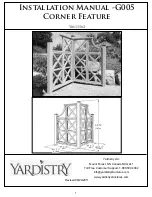
26.
Series 200a Fi User’s Guide
CAUTION
We use the term CAUTION to inform you about situations that could
result in serious damage to the instrument or other equipment.
Details about these circumstances are in a box like this one. Be sure
that all instrument operators read and understand the
precautions listed below.
•
External input/output are for contact closure. Never apply voltage to the External
input/output.
•
As the detector is readily affected by the ambient temperature, use it in places where there
is little wind or change in the ambient temperature. Do not use the detector near any
source of vibration, electrical noise, or in places where corrosive gas and a lot of dust exist.
•
Do not connect any tube other than the provided “OUT tube” to the outlet tubing of the
detector. Put the exit end of the “OUT tube” in the waste liquid bottle and do not apply
back pressure.
•
When connecting this detector to other detectors in series, put it last.
•
If eluent freezes inside the detector, the flow line might break and damage the detector. If
there is any chance of eluent freezing during stoppage or storage of the detector, withdraw
the eluent completely from the flow line of the detector.
•
When using any eluent containing a salt of high concentration, make sure that the flow line
is washed with water thoroughly after use. Failure to do so may result in the plugging of
the line causing the detector to cease operation.
•
If the detector is not to be used for more than one week, then, prior to storage, wash the
flow line with pure water or acetone, and store in isopropanol or 50% solution of
isopropanol and HPLC grade water.
•
Do not use any eluent which might corrode the material, such as stainless steel, that it
comes in contact with. Use of such eluent might cause a baseline drift and damage the
detector.
•
Use a dry cloth to wipe the detector. Do not use water or alcohol. Use of such liquids may
damage the detector or erase characters or color on the panel.
NOTE:
Do not connect any cord to the output signal terminal other than the attached signal cord.
NOTE:
Use a thoroughly degassed eluent. It is recommended that a degassing device be used to degas
the eluent as it is easy to use and permits continuous degassing.
NOTE:
If an eluent is replaced with another eluent in which it is insoluble, after having withdrawn the old
eluent from the line, wash the line with a solvent which is soluble in both eluents, and then fill the
line with the new eluent. For example, if water is replaced with chloroform, wash the line with
isopropyl before filling the line with chloroform.
NOTE: W
hen replacing an eluent containing salt with an eluent containing organic solvent, wash the line
with pure water and then isopropyl before filling the line with the organic- solvent-containing
eluent. In contrast when replacing an eluent containing organic solvent with an eluent containing
salt , wash the line with isopropyl first and then pure water before filling the line with salt-
containing-eluent.
Summary of Contents for 200A Series
Page 1: ...SERIES 200A FLUORESCENCE DETECTOR User s Guide LIQUID CHROMATOGRAPHY ...
Page 5: ...Introduction ...
Page 6: ......
Page 15: ...Safety Practices ...
Page 16: ......
Page 17: ......
Page 33: ...Safety Practices 33 Figure 2 2 Overview of the warning labels on the front of the instrument ...
Page 35: ...System Description 35 System Description ...
Page 36: ...36 Series 200a Fi User s Guide ...
Page 55: ...Installation 55 Installation ...
Page 56: ...56 Series 200a Fi User s Guide ...
Page 66: ...66 Series 200a Fi User s Guide ...
Page 67: ...Operation 67 Operation ...
Page 68: ...68 Series 200a Fi User s Guide ...
Page 117: ...Maintenance 117 Maintenance ...
Page 118: ...118 Series 200a Fl User s Guide ...
Page 154: ...154 Series 200a Fl User s Guide ...
Page 155: ...Troubleshooting ...
Page 156: ...156 ...
Page 162: ...162 Series 200a Fl User s Guide ...
Page 163: ...Appendix 163 Appendix ...
Page 164: ...164 Series 200a Fl User s Guide ...
Page 170: ...170 Series 200a Fl User s Guide ...
















































